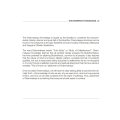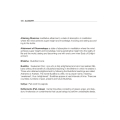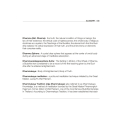Buddha-Bild : ค้นหาหนังสือธรรมะ หน้า 7 / 47
หน้าหนังสือทั้งหมด

181
Understanding External and Internal Fools in Buddhism
1) External Fools include non-Buddhists. They are determined to demolish Buddhism, whether they are of other religious affiliations or not. They typically try to cast aspersions upon Buddhist monks. W
In Buddhism, External Fools are non-Buddhists who seek to distort and undermine Buddhist teachings, casting aspersions on monks and creating confusion. Internal Fools, on the other hand, are Buddhists

198
Teaching Humility and Modesty Through Meditation
teaching ourselves humility and modesty. There may be times when an apology is required. Some difficulties are caused by our own carelessness, perhaps by damaging others' possessions, which can be sol
This text emphasizes the importance of humility and modesty, particularly in instances where apologies might be necessary due to personal oversights. It highlights the significance of staying calm and

253
Wat Buddha Centers in Europe
Paris
Wat Buddha Paris
10, Avenue de Paris, 77164 Ferrieres en Brie, France
Tel. +33-164-770-837
Mobile. +33-6-2285-8206
Fax. +33-164-772-837
Email: [email protected]
德國
Wat Phra Dhammakaya Bavä
Explore the Wat Buddha centers located in Paris and various cities in Germany, including Koenigsbrunn, Frankfurt, Stuttgart, and Langenargen. These centers provide spiritual services and a sense of co

255
Wat Buddha Locations in Sweden, Switzerland, and the UK
瑞典
Wat Buddha Gothenburg
Ostra Aroldgatan 17B.42443 Emsing Backa. Sweden.
Tel. + (46) -031-585799, + (46) -037-562722
Website : www.dhammadaya.se
E-mail : [email protected]
瑞士
Wat Buddha
Discover various Wat Buddha temples located in Sweden, Switzerland, and the UK. Each temple offers unique cultural experiences and is a place for meditation and community gatherings. The Wat Buddha Go

18
Understanding Dhammakāya and Theravāda Manuscripts
and is ‘spiritually reborn’. The dhammakāya becomes her new identity as the milk nourishes her spiritually. It is something she is given as a verbal teaching.
To add the material from the Apadānas is
This text delves into the doctrine of dhammakāya, representing a new spiritual identity that arises from teachings, akin to nourishment from milk. It connects the concepts found in the Agañña-sutta, i

37
Exploring the Concept of Dhammakāya in the Aggañña-sutta
IV. Reference 1: Dhammakāya as the Tathāgata’s Designation
The first Pali reference to the term dhammakāya that is well known to all previous works is a passage in the Aggañña-sutta, wherein the term
This text discusses the term 'dhammakāya' as referenced in the Aggañña-sutta, emphasizing its importance in defining an heir of dhamma and the Tathāgata’s true son. The conversation between the Buddha

38
Understanding the Concept of Dhammakāya in Buddhist Thought
D.III.84
Vāsettha and Bhāradvāja, he whose confidence in the
Tathāgata is settled, rooted, established, solid, irremovable by
any ascetic or brahmin, any deva or Māra or Brahmā or anyone
in the world
In this passage, Vāsettha and Bhāradvāja discuss the unwavering confidence in the Tathāgata, stating that those deeply rooted in dhamma can claim to be heirs of dhamma. The term 'dhammakāya' and its i

42
Saddhā: The Criterion of Being the Tathāgata's Son
Saddhā: Criterion of being the Tathāgata's Son
The first point to be looked at is the criterion of being the Buddha’s ‘true son’ which is, in this passage, defined by means of his
irremovable confiden
This text discusses the criterion of being the Tathāgata's son, emphasizing the irremovable confidence (saddhā) in the Buddha. It defines this confidence as settled and unchangeable despite external i

60
Understanding Dhammakāya: The Essence of Transcendental Dhamma
Arhatship (arahattamagga).86 Therefore, the particular path is not a mere ‘collective title’ of the path-constituents but the ‘essential totality’ by which a ‘body’ is defined.
The dependence of funct
This text discusses the concept of Arhatship and the definition of Dhammakāya in the context of Buddhist philosophy. It argues that the path should be seen as an essential totality, forming a 'body,'

13
The Story of the Buddha and Thevadas
among Buddhists, is a story of the Buddha from Dusit realm, who visited the earth as Siddhata, the royal son of King Suddhothana and Queen Maya.
The most quoted story of Buddhism concerns goddess M
The text narrates the story of the Buddha's earthly life as Siddhata, son of King Suddhothana and Queen Maya, and the roles of the goddess Mekkhala and the Bodhisatta. It depicts the themes of moralit

577
The Interfusion of Chinese and Indian Cultures in Central Asia
Visualization of the Buddhas: The Interfusion of the Chinese and Indian Cultures in Central Asia as Reflected in a Fifth Century Apocryphal Sutra." PhD Dissertation. Yale University. Yamabe, Nobuyoshi
This dissertation examines the merging of Chinese and Indian influences in Central Asia, particularly through apocryphal Buddhist texts. It also discusses various publications that delve into Buddhist

113
หลักฐานธรรมภายในคัมภีร์พุทธโบราณ ๑ ฉบับรวมงานวิจัยโดยอ้อ
หลักฐานธรรมภายในคัมภีร์พุทธโบราณ ๑ ฉบับรวมงานวิจัยโดยอ้อ
Answer: Because the beings have āpatti, [from that they] cannot see even though Buddha-s and Bodhisattva-s come. In addition, Buddha’s dharmak
บทความนี้สำรวจหลักธรรมที่ถูกบันทึกในคัมภีร์พุทธโบราณ โดยกล่าวถึงการที่ beings ไม่สามารถเห็นพระพุทธเจ้าได้เนื่องจากกรรมที่มีอยู่ หากใจไม่บริสุทธิ์ โดยมีการอ้างอิงถึงพระพุทธเจ้าที่ส่งแสงนำทาง แต่การเห็น

72
Velama Sutta: The Power of Good Will
The Voice of Abstaining
7. Velama Sutta
“If one were to develop even just one whiff of a heart of good will, that would be more fruitful than... if one with a confident mind were to undertake the tra
This text discusses the teachings of the Velama Sutta, emphasizing that developing even a small amount of good will is more fruitful than significant material offerings and merits. It illustrates how

61
Understanding Dhammakaya Knowledge
The Dhammakaya Knowledge is taught by the Buddha to constitute the transcendental, blissful, eternal, and pure Self of the Buddha. Dhammakaya doctrines can be found in the scriptures of all major Budd
Dhammakaya Knowledge is a profound teaching from the Buddha that emphasizes the transcendental, blissful, and pure nature of self. This concept is integral to all major Buddhist schools, including The

158
Understanding Dhamma and Enlightenment
Attaining Dhamma: meditative attainment; a state of absorption in meditation where the mind achieves super insight and knowledge; knowing and seeing according to the truths.
Attainment of Dhammakaya:
This content delves into the concept of Dhamma as a state of meditative absorption. It explains the attainment of Dhammakaya, where deep insight allows one to see the reality of life. Key terms such a

159
Glossary of Buddhist Terms
GLOSSARY 155
Dhamma (Skt. Dharma): the truth; the natural condition of things or beings; the law of their existence; the ethical code of righteousness; the whole body of religious doctrines as a sys
This glossary outlines significant Buddhist terms. Dhamma refers to truth and the natural law of existence as taught by the Buddha. Dhammacakkappavattana Sutta is recognized as the Buddha's first teac

18
Meetings with a Dhamma Master
Meetings with a Dhamma Master
the greatest possible goodness to humanity, the destruction of Mara, which is the behind-the-scenes influential power of evil in existence. For Christians, I suppose, th
In this enlightening dialogue with Luang Por, he emphasizes the importance of clearing one’s mind to combat Mara, the personification of evil similar to Satan in Christianity. Luang Por explains that

44
Meeting with Luang Por Dattajevo
Meeting #6
June 8, 2009 - Ashram
I did not see Luang Por for several months after our last chat. I left the Peace Revolution after helping them re-organize and re-imagine the project for the coming y
In June 2009, a group meets with Luang Por Dattajevo at his Ashram to discuss a book project on the life of the Lord Buddha. The meeting includes questions from the Peace Revolution team and a writing

46
Understanding the Buddha's Teachings
"You're asking, 'Why is the mind coarse, boorish, or ill-mannered?' The mind is coarse because of attachment, anger, greed. People are really obsessed with stuff. But the Buddha's mind combines itself
In his teachings, the Buddha discusses the coarseness of the mind due to attachment, anger, and greed. He identifies three groups of people in response to his teachings: true believers, non-believers,

92
Buddha's Teachings on Patience and the Eight Precepts
"First, we must try to go to them indirectly. Do you see? We will only be here for seven days so we must be patient. We should always train ourselves to speak kindly and by doing this, we will gain bi
This text emphasizes the significance of patience and kindness according to Buddha's teachings during a week of meditation while following the eight precepts. It highlights the importance of good mann
